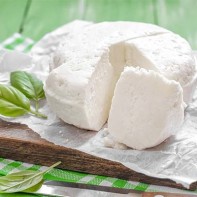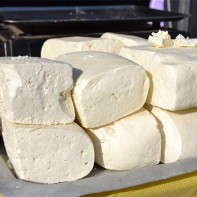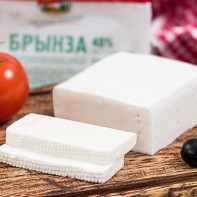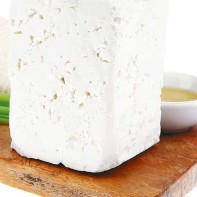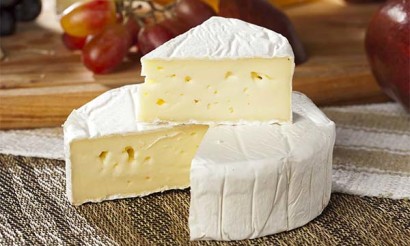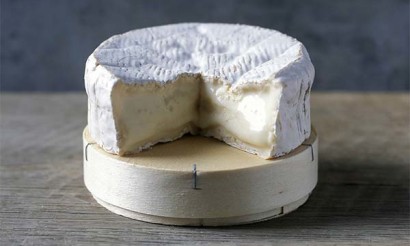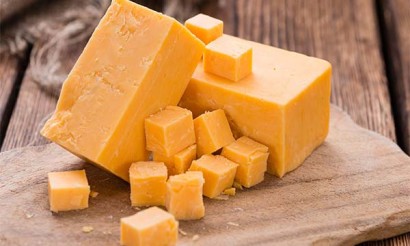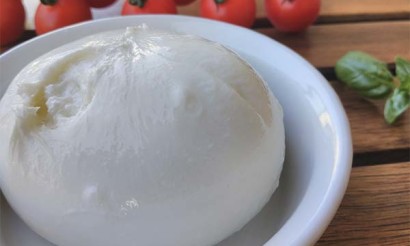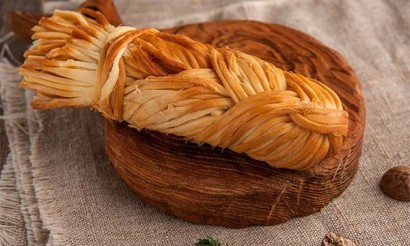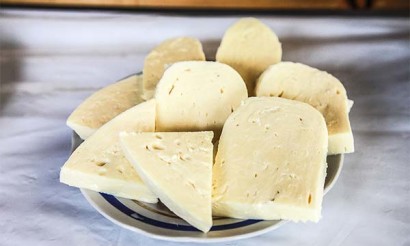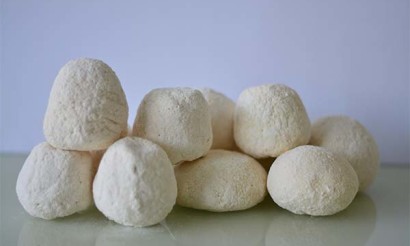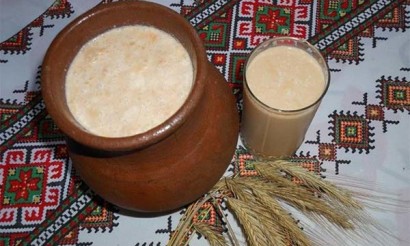Brynza: what kind of cheese is it, its composition and useful properties.
Traditional dishes of Caucasian, Eastern European cuisine rarely do without the sour milk product made from the milk of cows, sheep, goats and buffaloes. Unlike other cheeses, brine bryndza is not covered with a crust, does not have multiple voids, but from this it does not become less useful.
- Brynza cheese: characteristics, types and history
- History of origin
- Types
- Production technology
- What flavor and aroma
- Fat content
- Why it squeaks on your teeth
- Composition and calories
- Useful properties of bryndza
- Can I give it to children
- Can it be eaten while losing weight
- Bryndza consumption for diseases
- Diabetes
- Gastritis
- For pancreatitis
- Hazards and contraindications
- How to choose and store
- Where to buy and how much costs.
- What can be eaten and how is bryndza served?
- How to Make Bryndza at Home
- What can be cooked from bryndza
- Question-answer
- What to do if the cheese is bitter?
- How to properly soak from the salt?
- Does bryndza melt when fried and baked?
- What to substitute in the recipe?
- Interesting Facts
Brynza cheese: characteristics, types and history
Milky-white, slightly yellowish or with a creamy hue cheese, aged in brine, has a rich history, a long list of useful properties.
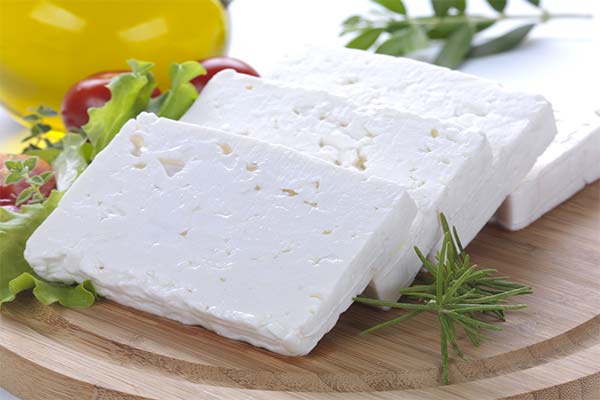
There are many types of bryndza, differing from each other by the peculiarities of production in each individual country. Europeans, Caucasians appreciate the product for its special unique taste, rich chemical composition, the ability to make dense, a little brittle cheese at home on their own.
History of Origin
Brynza is the progenitor of all cheeses. Its history goes back several thousand years. The first written mention of the cheese, dating back to 1370 year, was found in Croatia, the product was registered a hundred years later in Hungary.
Legend has it that the first bryndza came about by accident on the Arabian Peninsula. In the morning, before driving his cattle to another pasture, a shepherd took sheep's milk on the way, but he remembered it only at sunset. Imagine his surprise when after opening the wineskin he found, instead of milk, a turbid liquid with a thick white clot floating in it. According to another version, the discovery of sour milk product belongs to traveling merchant Kanan.
To preserve the miracle product, it was pressed and poured with a salt solution. This is how the technology for cooking bryndza was developed.
Types
Varieties of brine cheese, their features:
- Serbian. Any milk except cow's milk is used as a raw material. The characteristics of the species are a pleasant aroma, a dairy low-salt taste.
- Caucasian. Origin of raw materials is allowed any. Lamb's stomach as a starter was replaced by modern pepsin. For giving a brighter flavor dense pieces of ready product without holes are kept for 12 hours in brine.
- Georgian. Salted bryndza with a small number of voids is made from the fatty milk of sheep and goats. Salt is added immediately at the beginning of production.
- Ossetian. Cheese made from sheep's milk takes shape in the stomach of a sheep. Tastes like Greek feta.
- Turkish. Tender, low-salted, without added spices and spices sour milk product is often prepared from mixed natural raw materials. It is used as a separate dish or a component of salads.
- French. Cheese of loose consistency is made from classic raw materials with the addition of herbs. The salty product has a bright taste.
- Armenian. Dense without holes cheese mass with a moderate amount of salt is obtained from natural products with the addition of spices. The peculiarity of the species is a creamy aftertaste.
- Soybean. Brynza is produced by fermentation of melted soy milk. This low-calorie product is eaten by those wishing to get rid of excess weight and fasting people.
- Moldavian. Milk is not subjected to thermal processing, but the finished cheese is kept in brine for up to 40 days to prevent the development of pathogenic microorganisms and parasites. The product has a delicate, airy texture. In the south of Moldova, it is usually eaten with green onions.
Production Technology
To make bryndza from 100 liters of milk you will need 90 mg of rennet, rock salt. Cheese dairies have special equipment - pasteurizer, salting tank, table with sides for pressing, cloth with a rare weave of threads (serpentine).
Stages of sour-milk product production:
- Milk is heated in a pasteurizer, cooled to room temperature.
- The rennet is dissolved in water, added to the milk, stirred.
- Leave the raw material to ferment for 1-2 hours, until a white clot forms.
- Spread serpentine on a pressing table, lay out a dense clot on it. After the whey has drained, tie the ends of the cloth, set the press on top.
- After 3 hours the product is sprinkled with rock salt.
- Two or three days later, the bryndza is cut into equal slices and dropped into a 9% salt solution prepared in advance.
- After five days, it is ready to eat.
Aged cheese is obtained after a month of storage in a 14 percent brine.
What flavor and aroma
Cow's cheese, which is gaining in popularity, has a bright taste. It is more delicate than grainy sheep cheese with a characteristic flavor and has irregularly shaped holes.
Goat cream-colored bryndza is recognized by a specific smell, dense consistency. The product of homemade each hostess has a different shade of sour milk taste, smell, depends on the use of additives.
What is the fat content
Natural protein product refers to low-fat cheeses, recommended for dietary diets. For store brynza, this figure is 20 percent. Cheese made at home, the fat content can go up to 40-50%.
Why it squeaks on your teeth
Short-ripening brynza with low acidity contains a lot of calcium, intact protein structure.
Other causes of teeth squeaking:
- Adding stale sourdough, not enough rennet.
- Storage in the freezer.
- Prolonged boiling when pasteurizing raw materials.
- The introduction of artificial protein into the recipe in order to make production cheaper.
The product turns out "rubbery" if vinegar is used as a starter in home production.
Composition and calories
Mild cheese contains significant amounts of easily digestible calcium and phosphorus, zinc, magnesium, copper, manganese, 10 essential and 8 substitutable amino acids that support the structure of all body cells. The product is rich in vitamins B12, A, PP, unsaturated fatty acids.
Content of vitamins, minerals in 100 grams of bryndza:
Vitamins:
- Cobalamin - 0,002 mg;
- Nicotinic acid - 5 mg;
- A - 0.18 mg;
- Riboflavin - 0.12 mg;
- Calciferol - 0.001 mg;
- Pantothenic acid, 0.3 mg;
- Folates, 0.02 mg;
- Biotin, 0.003 mg;
- Pyridoxine, 0.07 mg;
- Thiamine, 0.04 mg.
Micronutrients:
- Zinc - 0.05 mg;
- Manganese - 0.1 mg;
- Copper, 3.7 mg;
- Iron - 0.7 mg.
Macronutrients:
- Sodium - 1200 mg;
- Chlorine - 1850 mg;
- Calcium - 630 mg;
- Phosphorus, 375 mg;
- Sulfur, 221 mg;
- Magnesium, 24 mg;
- Potassium - 95 mg.
The energy value of the sour-milk product - 262 kcal. GI - 22, 19 and 0.4 g, respectively.
Useful properties of bryndza
Because of the minimum heat treatment, 100 g of bryndza contains 63% of the daily norm of easily digestible potassium and half the daily requirement of the body in phosphorus. The product is useful for all age groups except kids under 1.5 years old. Children, pregnant and nursing mothers, the elderly, and menopausal women with advanced osteoporosis especially need calcium.
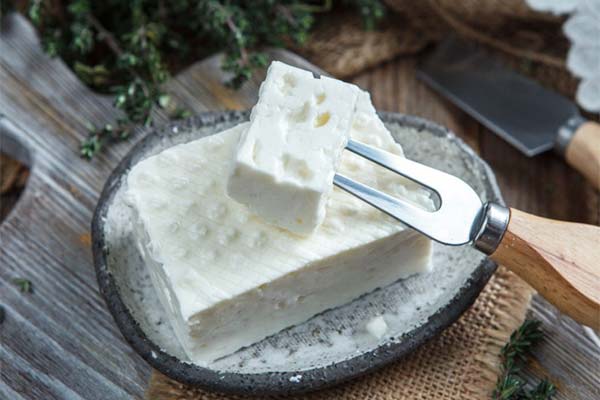
When including bryndza in the diet in an amount not exceeding 70 g per day:
- Blood cholesterol levels are normalized and the development of atherosclerosis is prevented.
- The work of the digestive organs is improved.
- Improves microflora, slows down putrefactive processes in the intestines.
- Blood vessels become elastic, the risk of heart attacks and strokes is reduced.
- Bone tissue and dental enamel become mineralized and thickened.
- Metabolism becomes normalized.
- Increases immune status.
Brine cheese supports the health of reproductive organs, skin, hair beauty, nail strength, which is important for women. Men bryndza gives energy, supplies protein for building muscle mass, increases physical endurance. Lovers of the fermented milk product retains male strength longer and increases the number of active sperm cells.
Can we give it to children?
Bryndza is given to children from two years of age after soaking to reduce salinity. The sour-milk natural product provides a child's body with proteins, which form the basis of all tissues and internal organs, vitamins, minerals, fatty acids:
- Calcium is involved in the formation of the skeleton, seals the tooth enamel.
- Vitamin D prevents the development of rickets.
- Cobalamin is involved in hematopoiesis.
- Omega-3 stimulates cognitive abilities, increases endurance, and helps students cope with the mental stress of school.
Cheese, which is digested by 95% in 1 hour, is useful to active children to quickly replenish the energy expended, the content of antioxidants that protect against seasonal colds. For teenagers, cheese helps get rid of skin problems.
Can I eat it while losing weight
The low-fat protein product is useful for shedding excess weight. Brynza supports the functions of the gastrointestinal tract, normalizes the microflora, and adjusts metabolic processes.
Dietitians recommend eating cheese fresh for breakfast and lunch as a separate dish or adding it to salads with fresh vegetables, not seasoned with vegetable oil. Because of the salt content, possible swelling, do not eat bryndza in the evening.
The use of bryndza for diseases
Brined cheese is contraindicated in diseases of the stomach mucosa, it is useful for people with diabetes, it is allowed with inflammation of the pancreas.
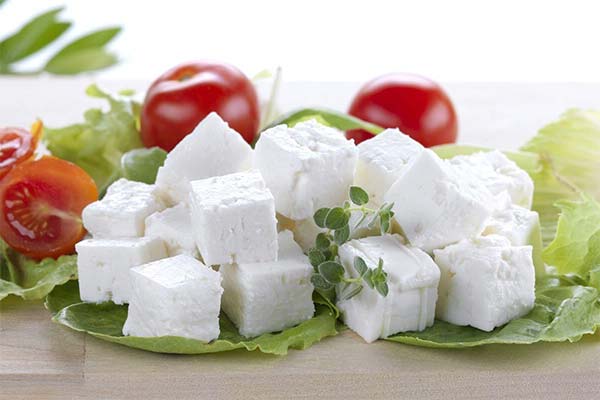
For Diabetes.
Unlike other cheeses, bryndza retains more vitamins and minerals that can support a weakened body.
Useful properties of bryndza with a zero glycemic index for diabetic patients:
- cholesterol elimination;
- maintenance of healthy skin;
- beneficial effects on the nervous system, digestive organs.
The amount of bryndza consumed is limited by the daily norms of proteins, fats, the degree of salinity.
For gastritis
Cheese is included in the diet in stable remission in minimal doses. To reduce the symptoms of the disease, first of all provide rest to the mucosa of the stomach. Salt, the acid in brynza provoke aggravation, painful attacks. For this reason, doctors do not recommend eating the product, regardless of the type, salt concentration.
In pancreatitis.
Unsalted natural bryndza is allowed to include in the diet of people with acute and chronic forms of pancreatitis. This type of cheese does not require a lot of gastric juices to digest, which is important in pancreatic inflammation.
Harms and contraindications
It is worth refraining from eating sodium-rich brine cheese without pre-soaking for the following health problems:
- Kidney, liver, gallbladder, and biliary tract dysfunction;
- hypertension;
- tendency to edema;
- Exacerbation of pancreatitis, gastritis.
Contraindications include children under two years of age, lactose intolerance.
How to choose and store
Quality brynza can not be called a lightly salted cheese product, covered with a dried crust, have an uneven color.
The composition of the natural product, which can be read on the package, includes only milk, enzymes, sourdough, salt. The presence of harmless calcium chloride, which plays the role of a hardener, is acceptable.
The taste of the cheese is known by the fat content. The higher the percentage of fat content, the structure is less brittle and the taste is closer to creamy. Bryndza from the milk of cows is more salty, sheep - dry, goats - fatty with a specific flavor.
It is worth considering that the fresher the dairy product, the less salty it is. About the spoilage of bryndza can be recognized by an acidic smell, yellow spots on the surface, gray and brown specks in the mass of milk color. The presence of preservatives - the absence of brine.
Bryndza retains consumer properties:
- in the refrigerator up to three weeks in a container with brine;
- Up to one week, wrapped in parchment, foil;
- 10 days in hermetically sealed original packaging, 5 days in the open;
- at room temperature for 6 hours without brine, two days in a salt solution;
- In the freezer 8 months, but loses some of its useful properties.
If through ignorance or accident the "native" brine poured out, you can make your own slightly salted solution. It keeps bryndza for two weeks in the refrigerator. Another option for long-term preservation of nutritional value is storing tightly packed slices of cheese in a glass jar in the cold.
Can you freeze cheese?
Send bryndza to the freezer is possible, but undesirable. After defrosting, the product loses aroma, taste, becomes loose, crumbles due to the formation of ice crystals in the structure. Useful bacteria that improve intestinal microflora are killed.
Where to buy and how much it costs
Brynza is sold in supermarkets, online stores, at food fairs and markets, where farmers and private individuals offer their own production.
Cheese wholesale for 270-350 p.. 1 kg. at retail - 750 to 2000 p..
What do they eat and how do they serve bryndza?
Traditionally, the cheese is cut into cubes. Dry types of bryndza are dressed with olive oil, while the strong salty taste is masked with dried spicy herbs, sprinkling the cheese on top.
Eaten as a separate dish with green onions, fresh tomatoes, wash down with white wine. For breakfast, the product is served with baked goods for tea.
How to make bryndza at home
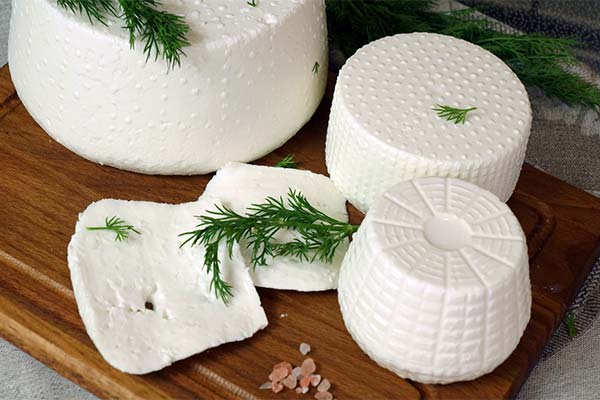
To make homemade cheese according to the classic recipe, you will need:
- A liter of fat cow's milk (preferably homemade);
- 30 ml of lemon juice;
- 3 tbsp. extra-fat sour cream;
- 5 g salt;
- a glass of water.
Cooking algorithm:
- Turn on the stove burner to maximum heat. Put a deep pan of milk on it.
- Enter the sour cream, stir with a wooden spoon.
- At the beginning of separation of the homogeneous mass of whey and clot, add the juice of lemon, after a minute the pan is removed from the stove.
- Folded in several layers of gauze is moistened, put in a colander, pour the contents of the pan on top.
- After draining the whey, the clot in the gauze is pressed under pressure for one hour.
- From water and salt make a brine, in which the cheese slices are dipped. After 30 minutes the bryndza is ready.
Based on the basic recipe make original homemade cheeses by introducing additional ingredients - eggs, dill, garlic, a mixture of peppers, chili, cumin.
The leaven in the form of sour cream and lemon juice can be replaced by the digestive enzyme pepsin. It is dissolved in a small amount of water beforehand, poured into the milk heated to 30 degrees. Further actions are identical to the preparation according to the classic recipe.
The production of goat's milk bryndza differs only in a longer time of fermentation, soaking in brine (at least 6 hours).
What can be made with bryndza
Bryndza is served as an independent appetizer, with it make sandwiches, prepare first and second courses, baked goods. In cuisines around the world popular with brynza:
- meat cutlets uštipci by the Serbs;
- Slovak dumplings, moussaka;
- Potato dumplings by the Poles;
- Bulgarian buns milinka, tortillas, stuffed peppers, onion soup;
- French cacote bread, ratatouille.
In Russia, bryndza is an ingredient of Greek salad, sandwiches, pita rolls, sour cream sauce, cheese balls, zrazy, open pies, pizza. It is added to omelets, covered with grated cheese vegetables and meat when baked.
In the Caucasus sour-milk product is included in the recipe of khachapuri, samsa, Ossetian pies. Bryndza is combined with bread, tomatoes, eggplants, potatoes, onions and garlic.
Q&A
Consumers are interested in answers to questions related to the use of bryndza, improving its flavor, changes in characteristics during heat treatment.
What to do if the cheese is bitter?
Brynza bitters when poor-quality additives are introduced in the recipe, deviations from the production technology or improper storage.
Regardless of the cause of the defect bitterness is eliminated by soaking for two hours in cold water. If the bitterness is not gone, the product is thrown away.
How to properly soak from salt?
Dairy product will become less salty and more dense if it is immersed for 8 hours in milk, whey or warm (not hot) water. To the process of soaking was more active, bryndza cut into plates width of 2-3 cm, water or whey change every couple of hours.
Important! If you pour boiling water over the cheese and keep until the water cools, the consistency of the cheese is close to chewing gum.
Does bryndza melt when grilled and baked?
Briny natural cheese melts well when heated in a pan or oven, without conflicting with other products. Due to this property with cheese baked cakes, pies, pies.
The ability of bryndza to melt, preserving the flavor, but not to melt, is used to cover the pizza crust immediately after the tomato paste.
What to substitute in a recipe?
Bryndza in salads, sandwiches, and baked goods are substituted for:
- suluguni;
- feta;
- mozzarella;
- Ossetian, Lebanese, and Adygean cheeses that go well with fresh vegetables.
Analogues have different shades of flavor, but they all belong to the young brine cheeses, making dishes more tasty and hearty.
Interesting Facts
Informative and surprising facts about bryndza:
- The inhabitants of the Carpathians call the product Viagra or white gold, believing in its ability to maintain manhood until old age.
- To get 1 kg of sour milk product, 5 liters of cow's milk and 3 times as much of sheep's milk are needed.
- Bryndza is a mandatory ingredient in more than 30 dishes.
- The creamy taste of brine cheese has a dense consistency.
- Cheese starter peptin replaced the stomach enzymes of newborn lambs.
Useful bryndza is not difficult to make at home, if you can find the right amount of homemade whole milk. Nutritionists advise consuming the natural product in the first half of the day in moderation in combination with foods containing dietary fiber.
«Important: All information on this site is provided for informational purposes only. for informational purposes only. Please consult with your health care professional before using any of the recommendations. specialist before using any of the recommendations. Neither the editors nor the authors shall be liable for any possible harm caused by materials."

